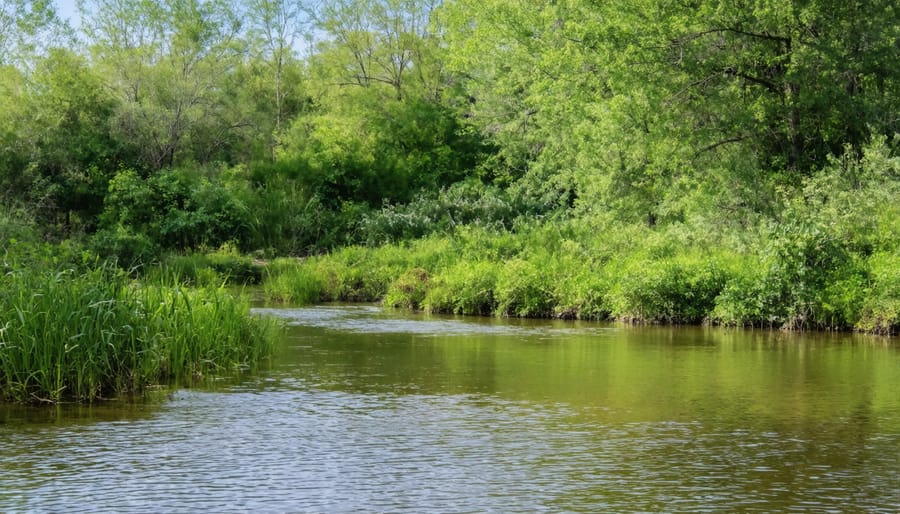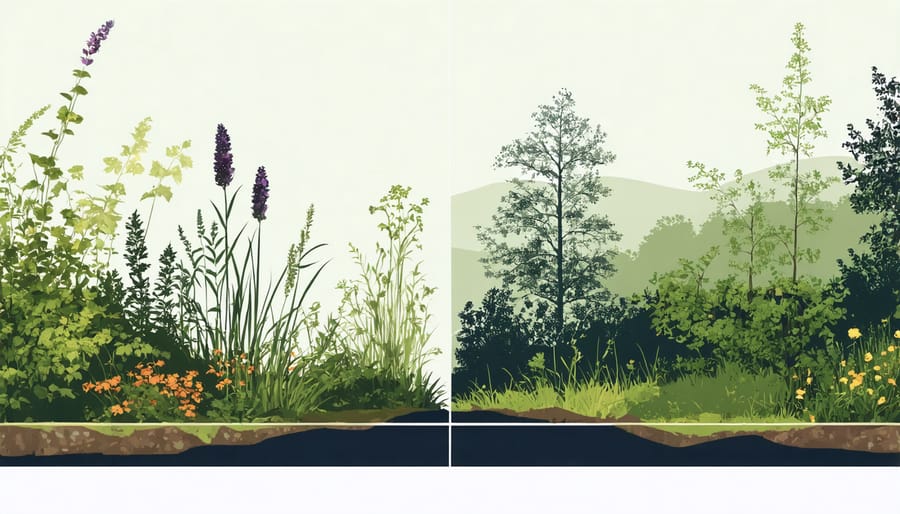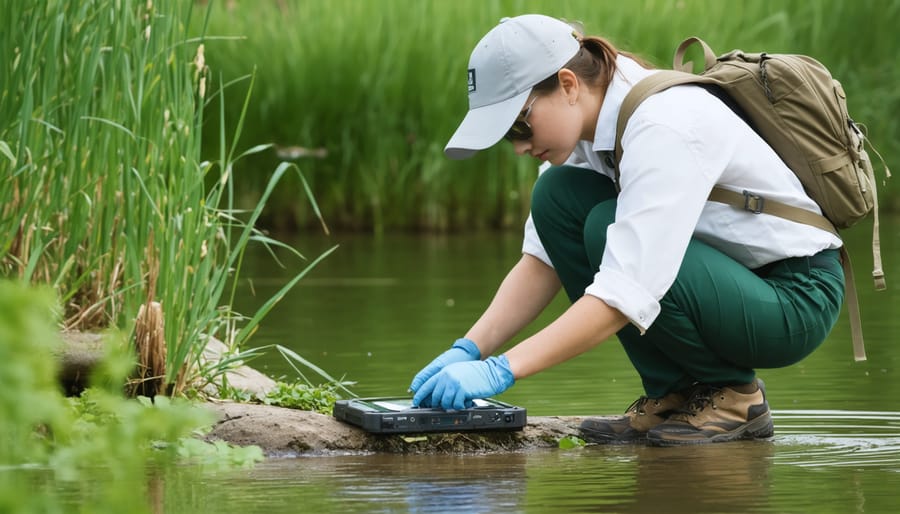
How a Riparian Ecologist Can Transform Your Pond’s Health
Riparian ecologists stand as vital guardians of our waterways, wielding scientific expertise to protect and restore the delicate zones where land and water meet. These specialized environmental scientists study the complex relationships between water bodies, soil conditions, and the diverse plant and animal communities that thrive along stream banks, riverbanks, and pond edges. Their work extends far beyond mere observation – they design restoration projects, monitor ecosystem health, and develop sustainable management strategies that benefit both wildlife and human communities.
In an era of increasing environmental challenges, riparian ecologists play a crucial role in maintaining water quality, preventing erosion, and preserving biodiversity. Their understanding of how vegetation, water flow, and wildlife interact helps create resilient ecosystems that can withstand flooding, drought, and climate change. Whether working in urban streams, agricultural watersheds, or pristine wilderness areas, these professionals combine field research with practical solutions to ensure our waterways remain healthy and functional.
By blending scientific knowledge with hands-on conservation work, riparian ecologists help bridge the gap between environmental science and practical land management, making them indispensable partners in protecting our precious water resources for future generations.
The Critical Role of Riparian Zones in Pond Health
Understanding Water-Land Interactions
The fascinating plant-water ecosystem relationships in riparian zones create nature’s perfect filter system. These transitional areas between land and water act like natural sponges, catching sediments and filtering pollutants before they reach the water. Think of riparian zones as your pond’s protective barrier – they slow down rainwater runoff, prevent erosion, and trap excess nutrients that could otherwise cause algae problems.
The plants in these zones do more than just look pretty. Their roots create a complex underground network that stabilizes banks and provides homes for beneficial microorganisms. Above ground, they offer shelter for wildlife and shade that helps maintain water temperature. When leaves and plant materials naturally fall into the water, they become food for aquatic insects and fish, completing a vital nutrient cycle.
Healthy riparian zones also act as natural flood control systems. During heavy rains, they absorb excess water like a giant sponge, releasing it slowly over time. This helps prevent flooding and maintains steady water levels in your pond, creating a more stable environment for all your aquatic friends.

Natural Filtration Systems
Nature’s own water purification system is truly remarkable, and riparian vegetation plays a starring role in this process. Plants along the water’s edge act like living filters, catching and processing various pollutants before they can enter the water body. Their root systems are particularly effective at trapping sediments and absorbing excess nutrients like nitrogen and phosphorus, which could otherwise cause algae blooms.
Different types of plants contribute to this natural filtration process in unique ways. Tall grasses and reeds catch debris and slow water flow, allowing sediments to settle. Meanwhile, submerged plants oxygenate the water and provide surfaces for beneficial bacteria to grow. These bacteria break down harmful compounds and help maintain water quality.
The filtering action of riparian plants isn’t just about removing pollutants – it also helps maintain water clarity. As water moves through dense vegetation, particles get trapped, much like a coffee filter catches coffee grounds. This natural process is so effective that many modern water treatment facilities actually mimic these natural systems using constructed wetlands.
For the best filtration results, a diverse mix of native plants is ideal, creating multiple layers of protection for your water body.
Plant Selection and Management Strategies
Native vs. Non-Native Species
When designing your pond’s riparian zone, understanding the difference between native and non-native species is crucial. Native plant selection plays a vital role in creating a sustainable and thriving ecosystem.
Native plants have evolved alongside local wildlife over thousands of years, making them perfectly adapted to your region’s climate and soil conditions. They require less maintenance, are more drought-resistant, and provide essential food and shelter for local birds, butterflies, and beneficial insects. These plants also have deep root systems that help prevent erosion and naturally filter water runoff.
Non-native species, while sometimes attractive, can pose serious risks to your pond’s ecosystem. Some exotic plants can become invasive, outcompeting native species and disrupting the natural balance. They might not provide the right nutrition for local wildlife or could even harm them. Additionally, non-native plants often need more water, fertilizers, and ongoing maintenance to thrive in an environment they weren’t designed for.
Consider plants like local rushes, sedges, and wildflowers that naturally grow near water bodies in your area. These choices not only create a beautiful, natural-looking pond edge but also contribute to the overall health of your local ecosystem. Your local nursery or extension office can help identify suitable native species for your specific region.

Seasonal Maintenance Calendar
Spring brings exciting opportunities for riparian zone maintenance! In March and April, begin by removing winter debris and dead vegetation. This is also the perfect time to assess any erosion damage from winter storms and plan your planting strategy. Install new native plants while the soil is moist and temperatures are mild.
Summer months (June-August) focus on monitoring plant growth and managing invasive species. Keep an eye on water levels and ensure your riparian buffer stays hydrated during dry spells. Regular weeding sessions every 2-3 weeks will prevent unwanted species from taking over. Early morning or evening maintenance works best to avoid peak heat.
Fall maintenance (September-November) involves selective pruning of overgrown vegetation and collecting seeds from successful native plants for future use. Remove fallen leaves from water features to prevent excess nutrient buildup, but leave some natural debris for wildlife habitat. October is ideal for planting trees and shrubs, giving roots time to establish before winter.
Winter (December-February) is your planning season. Use this time to review your riparian zone’s performance, document changes, and research new native species to introduce in spring. While active maintenance slows down, continue monitoring for erosion issues, especially after storms. Maintain wildlife corridors by leaving some standing vegetation for winter habitat.
Remember to adjust this schedule based on your local climate and specific site conditions.
Problem-Solving Common Issues
Riparian zones can face several common challenges that require careful attention and specific solutions. One of the most frequent issues is soil erosion along waterways, which can be addressed by strategically planting deep-rooted native vegetation to stabilize banks. When dealing with eroding areas, consider using biodegradable erosion control mats alongside your plantings to provide immediate protection while plants establish themselves.
Another significant challenge is managing invasive species that can quickly overtake native vegetation. Regular monitoring and early intervention are crucial – remove invasive plants as soon as you spot them, making sure to extract the entire root system. For larger infestations, you might need to implement a staged removal approach to prevent sudden erosion.
Poor water quality often stems from inadequate buffer zones. The solution involves creating wider vegetated strips along waterways, using a mix of grasses, shrubs, and trees to filter runoff. If you notice murky water or excessive algae growth, consider expanding your riparian buffer and adding more diverse plant species.
Flooding can damage riparian vegetation, but you can increase resilience by selecting flood-tolerant species and creating graduated planting zones. Start with water-loving plants nearest the water’s edge and gradually transition to more drought-tolerant species upland. This creates a natural and effective buffer that can withstand varying water levels while maintaining ecological function.
DIY Riparian Management Tips
Essential Tools and Techniques
A well-equipped riparian ecologist relies on both traditional and modern tools to effectively manage waterside vegetation. The most essential hand tools include pruning shears, loppers, and bow saws for vegetation maintenance. A sturdy pair of water-resistant boots and thick gloves are crucial for protecting yourself while working near water.
For water quality monitoring, basic testing kits measure pH, dissolved oxygen, and nutrient levels. A refractometer helps assess water salinity, while turbidity tubes measure water clarity. Digital cameras and GPS units are invaluable for documenting changes and mapping vegetation patterns over time.
Plant identification guides and soil sampling tools help determine suitable native species and soil conditions. Many ecologists now use mobile apps for quick plant identification and data collection in the field. Biodegradable marking flags and measuring tapes are essential for marking study areas and tracking plant growth.
For larger projects, mechanical tools like brush cutters and chainsaws might be necessary. However, these should be used carefully to minimize disturbance to the ecosystem. Erosion control materials, including biodegradable mats and stakes, help stabilize banks during restoration work.
Data collection techniques typically involve quadrat sampling, where a square frame helps measure plant density and diversity. Transect lines running perpendicular to the water’s edge allow for systematic vegetation surveys. Photo monitoring points provide visual records of changes over time.
Modern ecologists also employ drone technology for aerial mapping and GIS software for analyzing spatial data. These high-tech tools complement traditional field methods, offering comprehensive insights into riparian ecosystem health and management needs.

Monitoring and Assessment
Regular monitoring of your riparian zone is crucial for maintaining a healthy pond ecosystem. The good news is that you don’t need fancy equipment to measure pond biodiversity and assess the overall health of your waterside environment.
Start by observing the plant diversity along your water’s edge. A healthy riparian zone should have various plant layers, including ground covers, shrubs, and possibly trees. Look for signs of native plant growth and note any invasive species that might need addressing.
Water quality is another key indicator. Clear water usually suggests good health, while murky or algae-filled water might indicate problems. Check the water’s edge for erosion, which appears as exposed soil or steep, unstable banks. Healthy riparian zones have gentle slopes with well-established vegetation.
Wildlife activity is a fantastic measure of your riparian zone’s health. Keep a journal of the birds, insects, and amphibians you spot. More diverse wildlife typically means a healthier ecosystem. Look for signs like bird nests, frog spawn, or dragonflies, which are great indicators of a thriving environment.
Take seasonal photos from fixed points around your pond. This visual record helps track changes over time and spot potential issues early. Pay attention to changes in vegetation coverage, water levels, and bank stability.
Remember that a healthy riparian zone changes naturally throughout the year. Some die-back in winter is normal, but extensive bare patches or erosion require attention. Regular monitoring helps you catch problems early and maintain your pond’s natural beauty and ecological function.
Working with Professional Ecologists
While many riparian zone issues can be handled through DIY approaches, there are times when consulting a professional riparian ecologist is not just helpful but necessary. These experts bring specialized knowledge and experience that can be invaluable for complex situations or large-scale projects.
Consider seeking professional help when dealing with severe erosion problems, persistent water quality issues, or when planning major landscape changes near water bodies. Riparian ecologists are particularly valuable if you’re managing property that includes protected species or if you need to comply with local environmental regulations.
To find a qualified riparian ecologist, start by contacting your local conservation district or environmental agency. These organizations often maintain lists of certified professionals and can provide recommendations based on your specific needs. Universities with environmental science programs may also connect you with experts or recent graduates specializing in riparian ecology.
When working with a professional ecologist, prepare by documenting your concerns and gathering information about your property’s history. Photos, water test results, and records of previous management efforts can help them assess your situation more effectively. Be ready to discuss your goals, budget, and timeline for the project.
A good riparian ecologist will:
– Conduct a thorough site assessment
– Provide detailed written recommendations
– Explain their findings in understandable terms
– Offer multiple solutions when possible
– Help you understand maintenance requirements
– Guide you through any necessary permit processes
The cost of professional services varies widely depending on the scope of work, but consider it an investment in your property’s long-term health. Many ecologists offer initial consultations at reasonable rates, allowing you to discuss your needs before committing to a larger project.
Remember that working with a professional doesn’t mean giving up control of your property. The best ecological consultants will teach you about your ecosystem while helping you make informed decisions about its management.
Creating a thriving pond ecosystem requires understanding and respecting the delicate balance of riparian zones. By implementing proper management techniques, you can enhance water quality, support local wildlife, and create a beautiful waterscape that brings joy for years to come. Remember to maintain native vegetation, control erosion, and monitor water quality regularly. Small actions, like reducing chemical use and preserving natural buffer zones, make a big difference in protecting these vital ecosystems. Whether you’re managing a backyard pond or larger water feature, your efforts contribute to the broader environmental health of your local watershed. Stay curious, keep learning, and enjoy watching your pond flourish as you apply these sustainable management practices. Your pond isn’t just a water feature – it’s a living ecosystem that connects you to nature’s incredible web of life.
